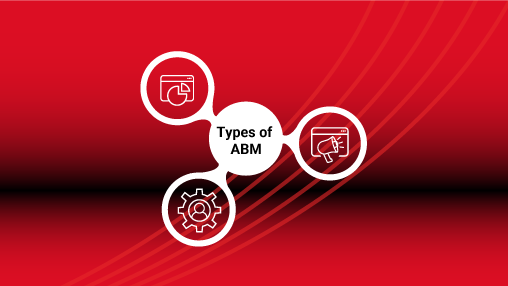In B2B marketing, account-based marketing (ABM) is a term that everyone recognizes, but it comes in different forms to suit various business needs and budgets. The key question isn’t if you should use ABM, but which type is best for your company’s goals and resources.
This blog breaks down the three main types of ABM:
It provides a clear look at each one to help you make informed decisions. By understanding these approaches better, you’ll be able to choose an ABM strategy that gives you the best return on your marketing efforts. Indeed, our research shows that 92% of mature ABM programs yield a higher ROI than any other marketing strategy, and 77% of ABMs state greater success in their targeted efforts than through other marketing methods.
Discover more about the core benefits of account-based marketing here.
| Feature | Strategic ABM | ABM Lite | Programmatic ABM |
| Target audience | Few (1-50) high-value accounts | Groups (50-500) with similar needs | Hundreds to thousands of accounts |
| Personalization | Very high; tailored to each account | Segment-based personalization | Broad, automated personalization |
| Complexity | High; individual account focus | Moderate; segment-level strategy | Low; technology-driven |
| Resources | Resource-heavy; intensive personalization | Less intense than strategic; segment focus | Least intense; automation-focused |
| Tools | Advanced CRM, content tools, analytics | Scalable CRM and content tools | Automation tools, programmatic ads, AI analytics |
| Objective | Deepen relationships via tailored interactions | Convert segments with similar needs | Engage a wide audience efficiently |
| Sales alignment | Close; deep engagement with accounts | Collaborative; targeted account segments | Informed; automated prioritization |
| Metrics | Qualitative; deep engagement analysis | Mix of qualitative and quantitative | Quantitative; performance metrics |
| Top tactics | 1. Bespoke events 2. Tailored content 3. Direct mail 4. Personalized outreach 5. Account insights | 1. Webinars 2. Email campaigns 3. Targeted content 4. Social media engagement 5. Targeted ads | 1. Digital ads 2. Dynamic emails 3. Programmatic ads 4. Content syndication 5. Lookalike audience targeting |
1. Strategic ABM (One-to-One)
Strategic account-based marketing is the highest level of personalized marketing. It focuses on engaging each high-value account individually, treating each one like its own market. This approach requires a lot of time and creativity, making it the most resource-intensive type of ABM.
Execution of Strategic ABM
A successful Strategic ABM approach typically follows several steps:
- In-depth research: Comprehensive understanding of the account’s business drivers, market position, and internal influencers
- Custom messaging development: Crafting of tailored content and messaging that align closely with the account’s goals and values
- Personalized engagement: Deployment of customized tactics ranging from individual outreach efforts to personalized digital experiences, such as:
- Customized direct mail and thoughtful gift campaigns
- Account-specific web experiences through microsites and landing pages
- Bespoke content assets, including whitepapers and case studies
- Targeted digital marketing tailored to the account’s specific context
- Exclusive events and experiences designed to build and deepen relationships
Benefits of Strategic ABM
1:1 ABM programs offer multiple benefits through its highly personalized approach. It enhances customer relationships by treating each account uniquely, deepening connections, and increasing customer lifetime value with tailored interactions that boost retention. This targeted strategy also improves conversion rates by meeting specific account needs and preferences. Additionally, 1:1 ABM distinguishes a company in the marketplace with a unique value proposition tailored for high-value accounts, demonstrating its significant impact.
Utilization of Strategic ABM
According to our first-party ABM infographic research, findings reveal varied applications of 1:1 ABM among B2B marketers:
- 17% focus exclusively on existing clients to deepen relationships and increase account value
- 16% target only new accounts to attract and engage high-value prospects
- 65% employ a dual approach, targeting both existing clients and new prospects to maximize ABM effectiveness
Strategic ABM’s highly personalized and resource-intensive approach is a powerful strategy for building strong, value-driven relationships with key accounts, whether for deepening existing relationships or acquiring new ones.
2. ABM Lite (One-to-Few)
ABM Lite provides a balanced approach targeting groups of 20-100 accounts that demonstrate common traits, challenges, or industry backgrounds. This mid-tier strategy offers a compromise, maintaining a level of personalization higher than Programmatic ABM while requiring fewer resources than Strategic ABM.
Execution of ABM Lite
1:Few ABM enables marketers to implement semi-customized campaigns, optimizing resource use while ensuring that each account cluster receives attention tailored to their shared characteristics:
- Segmentation and targeting: Identify and group accounts into clusters based on shared attributes like industry, size, or specific pain points
- Customized campaign development: Create and deploy marketing campaigns that address the common needs and interests of each account cluster:
- Account-based advertising: Employ platforms to deliver targeted ads to clusters across various channels including social, web, and connected TV
- Direct mail and gifting: Send customized mail items or gifts to engage key stakeholders within the clusters
- Personalized email marketing: Execute email campaigns with content and messaging designed specifically for each cluster
- Tailored events and webinars: Organize virtual or physical events like webinars or roundtables that cater to the specific interests of the target clusters
- Sales enablement: Arm sales teams with cluster-specific content and insights to enhance their engagement strategies
- Website personalization: Utilize IP-based personalization tools to show relevant content to visitors from targeted accounts on the website
Benefits of ABM Lite
1:Few ABM is particularly useful for companies with moderate marketing resources – it allows them to efficiently focus their efforts on more narrowly defined segments that closely resemble their ideal customer profiles. This level of customization helps in nurturing high-value prospects in a more targeted and meaningful way, potentially leading to better conversion rates compared to conventional broad-spectrum marketing.
3. Programmatic ABM (One-to-Many)
Programmatic ABM represents a scalable, technology-centric approach within account-based marketing, focusing on engaging a broad audience through automated and data-driven strategies. It’s designed for organizations aiming to extend their reach efficiently across numerous prospective accounts.
Execution strategy of Programmatic ABM
Through leveraging advanced technology and automation, 1:Many ABM conducts the following key steps to target and engage potential accounts at scale:
- Define target accounts: Identify a wide pool of potential customer accounts, possibly ranging into the hundreds or thousands, using detailed data and insights to ensure alignment with ideal customer profiles
- Build the marketing technology stack: Essential tools including ABM platforms, CRM systems, marketing automation, advertising technology, web personalization utilities, and data provisioning services form the backbone of a Programmatic ABM strategy
- Collect and enrich data: Gathering essential information on target accounts through various sources enables the creation of detailed account profiles. This step involves incorporating firmographic, demographic, intent, and engagement data
- Segment and prioritize accounts: Utilize the enriched data to categorize accounts based on specific criteria such as industry, revenue, technology stack, and purchase readiness. This aids in identifying both high-fit and high-priority targets
- Orchestrate multi-channel campaigns: Develop and implement personalized campaigns across a diversity of channels – email, web presence, content syndication, social media, programmatic advertising, and others – each customized to resonate with the segmented account groups
- Automate execution and optimization: Leverage automation and AI to deliver campaigns, adjusting in real time based on performance data to optimize reach, messaging, channel selection, and budget allocation
- Integrate with sales: Ensure a seamless transition of highly engaged accounts and leads to sales teams, utilizing CRM integration and scoring mechanisms that trigger alerts following predetermined engagement thresholds
- Measure and analyze: Deploy comprehensive analytics tools to scrutinize account engagement, assess campaign efficacy, and determine the impact on sales pipelines and revenue, fostering ongoing refinement of strategies
For more on measuring account-based marketing results, read our blog post that covers 10+ metrics.
Benefits of Programmatic ABM
The use of 1:Many ABM allows for a fusion of extensive reach and personalized marketing, thanks to its reliance on sophisticated automation and data analytics. This approach not only enhances efficiency but also empowers organizations to address a larger audience with tailored engagements, optimizing the resource allocation and potentially amplifying conversion effectiveness.
Utilization of Programmatic ABM
Programmatic ABM is implemented in various ways based on business needs:
- Approximately 23% of marketing professionals utilize Programmatic ABM to nurture existing client relationships and explore opportunities for upselling or cross-selling
- About 21% of marketers focus solely on acquiring new accounts using 1:Many strategies
- The majority, comprising 51%, adopt a hybrid approach using Programmatic ABM for both existing client retention and new account acquisition
These statistics highlight the versatility of 1:Many ABM in catering to both customer retention and acquisition objectives within diverse marketing contexts.
How to choose the right ABM approach
Selecting the right type of ABM strategy is crucial for maximizing your campaign’s effectiveness and ROI. The decision should be based on factors such as your target audience size, available resources, and marketing objectives. Here are some key considerations:
- Target account size: Strategic ABM is best suited for targeting a small number of high-value accounts (typically 1-5), as it requires significant resources and personalization. ABM Lite is ideal for a larger set of target accounts (usually 5-100), while Programmatic ABM is designed for a broad audience of hundreds or thousands of accounts
- Resources and budget: Strategic ABM demands a substantial investment of time, personnel, and budget due to its highly personalized nature. ABM Lite and Programmatic ABM are more cost-effective options, as they leverage automation and scalable tactics to reach a broader audience
- Personalization level: If your goal is to deliver an exceptional, highly personalized experience for a select few accounts, Strategic ABM is the way to go. ABM Lite allows for some personalization, while Programmatic ABM relies more on account-level segmentation and targeted messaging
- Sales alignment: Strategic ABM requires close collaboration between marketing and sales teams, as they work together to identify and engage key decision-makers within each target account. ABM Lite and Programmatic ABM can be more marketing-driven, with sales playing a supporting role
- Time to value: Strategic ABM often takes longer to yield results due to the extended sales cycles associated with high-value accounts. ABM Lite and Programmatic ABM can deliver quicker wins, as they target a broader audience and leverage more scalable tactics
Ultimately, the right ABM approach depends on your specific business goals, resources, and target audience. Many organizations adopt a blended strategy, combining elements of Strategic, Lite, and Programmatic ABM to cater to different segments of their target market.
Discover how Inbox Insight leverages ABM strategies to effectively engage key decision-makers within your target account list. Learn more about our ABM services and start connecting with your ideal prospects today.






